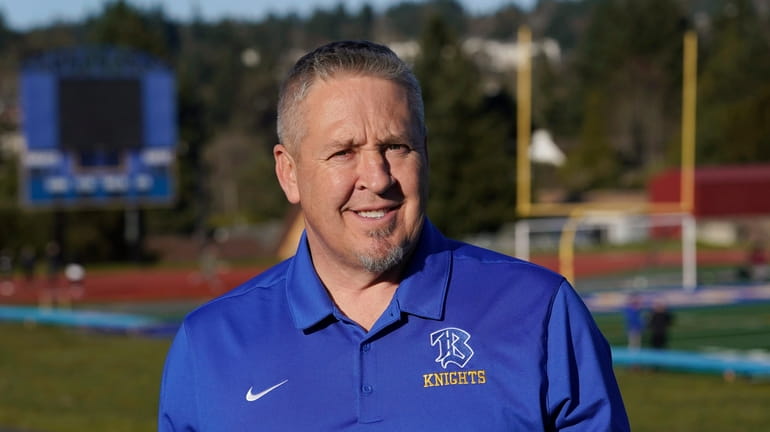Supreme Court toes a logical line on religion in two recent rulings

The Supreme Court ruled that Joe Kennedy, a former assistant football coach at Bremerton High School in Bremerton, Washington, could not be prevented from praying on the football field after a game even if his prayer was visible to students. Credit: AP/Ted S. Warren
In addition to abortion and guns, the Supreme Court also tackled issues of religious liberty in its recently concluded contentious term, with two rulings that have angered progressives. But is the court’s conservative majority opening the door to state-sponsored religious coercion as some warn, or are there more complex issues of government and religious liberty involved?
In Carson v. Makin, the court ruled 6-3 that the state of Maine could not exclude “sectarian” private schools from its tuition assistance program. In Kennedy v. Bremerton, it held that a football coach could not be prevented from praying on the football field after a game even if his prayer was visible to students — and if some of them joined in.
The court’s majority sees these rulings as upholding the free exercise of religion. Justice Sonia Sotomayor, who wrote stinging dissents in both cases, accuses the majority of seeking to dismantle “the wall of separation between church and state that the Framers fought to build.”
For much of America’s history, the state was far more entangled with religion than today — school-organized prayer in public schools was legal until 1962, and religious tests for state-level public office were common. The 1960s and 1970s saw the rise of “strict separationism” — the view that religious neutrality required total exclusion of religious expression from government spaces, or of religion-based programs from government support.
This sometimes led to results most people would consider bizarre — such as the exclusion of a child’s religion-themed drawing from a display of student artwork in a public school. In 1985, the Supreme Court ruled that a New York City program providing remedial reading and math classes to low-income children could not extend to parochial schools unless the classes were held in vans outside the school. The court reversed that decision 12 years later after the Clinton administration asked for a review.
By the 1990s, partly due to the court’s changing makeup, there was a shift toward a different understanding of neutrality as requiring equal treatment of religious and nonreligious viewpoints: For instance, a public university could not selectively deny funding to a Christian student magazine, and a public school could not stop students from forming a prayer club.
To me, as a pro-free speech, pro-religious liberty agnostic, this approach seems both logical and equitable. In a diverse and pluralistic society, its benefits are likely to accrue not only to Christians and Christian schools, but to Muslims, Jews, Hindus, Buddhists and others.
But this approach is also likely to introduce new conflicts. Should state subsidies go to religious schools that promote sexist or homophobic views and thus arguably violate civil rights protections? Can a teacher’s or coach’s personal religious expression create pressure on students to join in, an issue that Sotomayor believes the court disregarded in Kennedy v. Bremerton?
Gabriel Walters, an attorney with the Foundation for Individual Rights and Expression which filed a brief in support of the coach in Kennedy, told me that “coercion of especially elementary school students, but also high school students, in the context of public school prayer” is a legitimate issue; he also foresaw more conflicting claims between school employees who want to pray on the job and students who feel coerced by authority figures.
But these are conflicts a free society should be able to handle. The push to make religion untouchable in the public sector has not only fueled culture wars on the right, but infringed on individual freedom and viewpoint diversity. A course correction is welcome.
Opinions expressed by Cathy Young, a senior fellow at the Cato Institute, are her own.

